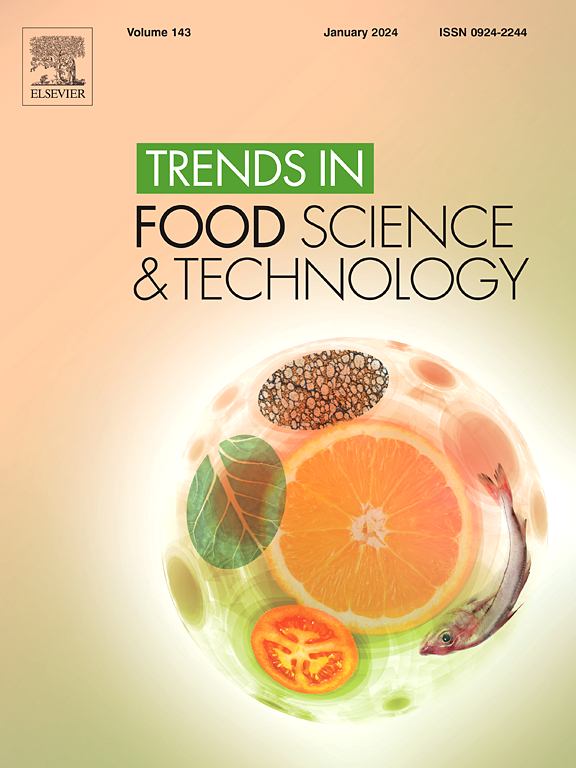Research progress on the formation, influencing factors, and mitigation strategies of advanced glycation end products in meat-based foods during frozen storage and processing
IF 15.1
1区 农林科学
Q1 FOOD SCIENCE & TECHNOLOGY
引用次数: 0
Abstract
Background
Meat-based foods are rich in proteins and fats and serve as important sources of essential nutrients for the human body. However, these nutrients are highly susceptible to oxidation during frozen storage and processing, which may lead to the formation of advanced glycation end products (AGEs) and their precursors. This contributes to the development of various chronic diseases, such as diabetes, Alzheimer's disease, chronic kidney disease, and cancer. Therefore, understanding the formation mechanisms of AGEs and appropriate mitigation strategies to enhance the nutrition and safety of meat-based foods is crucial.
Scope and approach
This paper reviews the formation mechanisms of AGEs during frozen storage and processing, provides a comprehensive analysis of the various factors influencing AGE formation, and summarizes a series of effective strategies to inhibit AGE formation.
Key findings and conclusions
First, the formation of AGEs in meat-based foods primarily occurs through oxidation reactions (protein and fat oxidation) and the Maillard reaction. Second, many factors influence AGE formation, such as the type of raw meat, frozen storage conditions, thermal processing parameters, and the application of food additives. Finally, the paper summarizes measures to inhibit AGE formation in meat-based foods in three ways: optimizing storage and processing parameters, using natural compounds as inhibitors, and combining new technologies with inhibitors. This paper will provide important theoretical foundations and guidance for reducing the formation of harmful substances in meat-based foods and protecting consumer health.

肉类食品冷冻储存和加工过程中晚期糖基化终产物的形成、影响因素及缓解策略研究进展
肉类食物富含蛋白质和脂肪,是人体必需营养素的重要来源。然而,这些营养物质在冷冻储存和加工过程中极易氧化,这可能导致晚期糖基化终产物(AGEs)及其前体的形成。这导致了各种慢性疾病的发展,如糖尿病、阿尔茨海默病、慢性肾病和癌症。因此,了解AGEs的形成机制和适当的缓解策略以提高肉类食品的营养和安全性至关重要。本文综述了AGE在冷冻贮藏和加工过程中的形成机制,综合分析了影响AGE形成的各种因素,总结了一系列抑制AGE形成的有效策略。主要发现和结论首先,肉类食品中AGEs的形成主要是通过氧化反应(蛋白质和脂肪氧化)和美拉德反应发生的。其次,影响AGE形成的因素很多,如生肉的种类、冷冻储存条件、热加工参数、食品添加剂的应用等。最后,本文从优化储存和加工参数、利用天然化合物作为抑制剂以及将新技术与抑制剂相结合三方面总结了抑制肉类食品AGE形成的措施。本文将为减少肉类食品中有害物质的形成,保护消费者健康提供重要的理论依据和指导。
本文章由计算机程序翻译,如有差异,请以英文原文为准。
求助全文
约1分钟内获得全文
求助全文
来源期刊

Trends in Food Science & Technology
工程技术-食品科技
CiteScore
32.50
自引率
2.60%
发文量
322
审稿时长
37 days
期刊介绍:
Trends in Food Science & Technology is a prestigious international journal that specializes in peer-reviewed articles covering the latest advancements in technology, food science, and human nutrition. It serves as a bridge between specialized primary journals and general trade magazines, providing readable and scientifically rigorous reviews and commentaries on current research developments and their potential applications in the food industry.
Unlike traditional journals, Trends in Food Science & Technology does not publish original research papers. Instead, it focuses on critical and comprehensive reviews to offer valuable insights for professionals in the field. By bringing together cutting-edge research and industry applications, this journal plays a vital role in disseminating knowledge and facilitating advancements in the food science and technology sector.
 求助内容:
求助内容: 应助结果提醒方式:
应助结果提醒方式:


